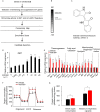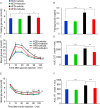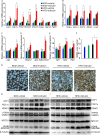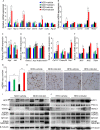Indirubin, a small molecular deriving from connectivity map (CMAP) screening, ameliorates obesity-induced metabolic dysfunction by enhancing brown adipose thermogenesis and white adipose browning
- PMID: 32190098
- PMCID: PMC7076951
- DOI: 10.1186/s12986-020-00440-4
Indirubin, a small molecular deriving from connectivity map (CMAP) screening, ameliorates obesity-induced metabolic dysfunction by enhancing brown adipose thermogenesis and white adipose browning
Abstract
Background: Obesity occurs when the body's energy intake is constantly greater than its energy consumption and the pharmacological enhancing the activity of brown adipose tissue (BAT) and (or) browning of white adipose tissue (WAT) has been considered promising strategies to treat obesity.
Methods: In this study, we took a multi-pronged approach to screen UCP1 activators, including in silico predictions, in vitro assays, as well as in vivo experiments.
Results: Base on Connectivity MAP (CMAP) screening, we obtained multiple drugs that possess a remarkably correlating gene expression pattern to that of enhancing activity in BAT and (or) sWAT signature. Particularly, we focused on a previously unreported drug-indirubin, a compound obtained from the Indigo plant, which is now mainly used for the treatment of chronic myelogenous leukemia (CML). In the current study, our results shown that indirubin could enhance the BAT activity, as evidenced by up-regulated Ucp1 expression and enhanced mitochondrial respiratory function in vitro cellular model. Furthermore, indirubin treatment restrained high-fat diet (HFD)-induced body weight gain, improved glucose homeostasis and ameliorated hepatic steatosis which were associated with the increase of energy expenditure in the mice model. Moreover, we revealed that indirubin treatment increased BAT activity by promoting thermogenesis and mitochondrial biogenesis in BAT and induced browning of subcutaneous inguinal white adipose tissue (sWAT) of mice under HFD. Besides, our results indicated that indirubin induced UCP1 expression in brown adipocytes, at least in part, via activation of PKA and p38MAPK signaling pathways.
Conclusions: Our results clearly show that as an effective BAT (as well as beige cells) activator, indirubin may have a protective effect on the prevention and treatment of obesity and its complications.
Keywords: Brown adipose tissue; Connectivity MAP; Energy expenditure; Indirubin; Obesity.
© The Author(s) 2020.
Conflict of interest statement
Competing interestsThe authors declare that they have no competing interests.
Figures








Similar articles
-
Emodin Improves Glucose and Lipid Metabolism Disorders in Obese Mice via Activating Brown Adipose Tissue and Inducing Browning of White Adipose Tissue.Front Endocrinol (Lausanne). 2021 May 10;12:618037. doi: 10.3389/fendo.2021.618037. eCollection 2021. Front Endocrinol (Lausanne). 2021. PMID: 34040579 Free PMC article.
-
Chronic l-menthol-induced browning of white adipose tissue hypothesis: A putative therapeutic regime for combating obesity and improving metabolic health.Med Hypotheses. 2016 Aug;93:21-6. doi: 10.1016/j.mehy.2016.05.006. Epub 2016 May 11. Med Hypotheses. 2016. PMID: 27372851
-
AMP-Activated Protein Kinase (AMPK) Regulates Energy Metabolism through Modulating Thermogenesis in Adipose Tissue.Front Physiol. 2018 Feb 21;9:122. doi: 10.3389/fphys.2018.00122. eCollection 2018. Front Physiol. 2018. PMID: 29515462 Free PMC article.
-
Human Brown Adipose Tissue and Metabolic Health: Potential for Therapeutic Avenues.Cells. 2021 Nov 5;10(11):3030. doi: 10.3390/cells10113030. Cells. 2021. PMID: 34831253 Free PMC article. Review.
-
White, brown, beige/brite: different adipose cells for different functions?Endocrinology. 2013 Sep;154(9):2992-3000. doi: 10.1210/en.2013-1403. Epub 2013 Jun 19. Endocrinology. 2013. PMID: 23782940 Review.
Cited by
-
Thermogenic Fat as a New Obesity Management Tool: From Pharmaceutical Reagents to Cell Therapies.Biomedicines. 2024 Jul 4;12(7):1474. doi: 10.3390/biomedicines12071474. Biomedicines. 2024. PMID: 39062047 Free PMC article. Review.
-
Pathophysiologically relevant bisphenol S exposure accelerates aging by disrupting brown adipose tissue-regulated energy metabolism.Proc Natl Acad Sci U S A. 2025 Jun 10;122(23):e2420437122. doi: 10.1073/pnas.2420437122. Epub 2025 Jun 2. Proc Natl Acad Sci U S A. 2025. PMID: 40455996
-
Identification of small molecules as novel anti-adipogenic compounds based on Connectivity Map.Front Endocrinol (Lausanne). 2022 Dec 16;13:1017832. doi: 10.3389/fendo.2022.1017832. eCollection 2022. Front Endocrinol (Lausanne). 2022. PMID: 36589834 Free PMC article.
-
High fructose and streptozotocin induced diabetic impairments are mitigated by Indirubin-3-hydrazone via downregulation of PKR pathway in Wistar rats.Sci Rep. 2021 Jun 21;11(1):12924. doi: 10.1038/s41598-021-92345-2. Sci Rep. 2021. PMID: 34155273 Free PMC article.
-
The Heartwarming Effect of Brown Adipose Tissue.Mol Pharmacol. 2022 Jul;102(1):460-471. doi: 10.1124/molpharm.121.000328. Epub 2021 Dec 21. Mol Pharmacol. 2022. PMID: 34933905 Free PMC article. Review.
References
LinkOut - more resources
Full Text Sources

